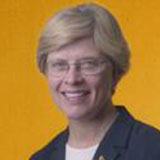Biography: Dr. Mary Lake Polan

My goal in becoming a physician was to do research that improves care for women.
Dr. Mary Lake Polan has combined rigorous scientific research with a humanistic clinical approach, in a carrer spanning women's health, clinical medicine, medical education, and governmental organizations.
Mary Lake was born in New Mexico in 1943. She obtained her bachelor's degree from Connecticut College, graduating cum laude and Phi Beta Kappa in 1965. She earned a Ph.D. in molecular biophysics and biochemistry in 1970, followed by a medical degree in 1975, both from Yale University School of Medicine. After completing her residency at Yale she held a fellowship in reproductive endocrinology in its department of obstetrics and gynecology. In 2001, after deciding to expand her efforts and research in women's health, Dr. Polan earned a master of public health degree in the Maternal and Child Health Program at the University of California, Berkeley.
Dr. Polan worked and taught at Yale University School of Medicine until 1990, with intervals as a visiting professor in Iran in 1978 and China in 1986. In 1990 she moved to Stanford University School of Medicine, where she has since served as chair of the department of obstetrics and gynecology and as the Katharine Dexter McCormick and Stanley McCormick Memorial Professor.
Dr. Polan has published more than 130 articles, chapters, and books in her areas of research, and in the laboratory at Stanford she focuses on reproductive endocrinology and infertility and, most recently, on gene expression patterns in uterine fibroids (benign tumors).
To help African women in dire need of corrective gynecological procedures, Dr. Polan organized a team of surgical volunteers to travel to East Africa. There, they operated on thirty-seven women in Asmara, Eritrea, to repair the physical damage resulting from prolonged labor during childbirth, a common problem in rural areas. The team had hoped to return to help the Eritreans establish a center for gynecological support and patient education at the local hospital.
The National Institutes of Health appointed Dr. Mary Polan co-chair of the Task Force on Opportunities for Research on Women's Health in 1991. From 1995 to 1998 she was also a member of the Director's Panel on Clinical Research. Dr. Polan was elected to the Institute of Medicine in 1993 and served on its Governing Council through 2005. At the request of Tommy Thompson, then Secretary of the Department of Health and Human Services, Dr. Polan served as one of eleven members of the Secretary's Advisory Committee on Human Research Protections through 2006. The committee was asked to advise on the responsible conduct of research involving human subjects. Dr. Polan also has served on numerous other medical and health committees, including the American Society for Reproductive Medicine and the American Medical Women's Association. She is a fellow of the American College of Obstetrics and Gynecology and a member of many professional societies.
What was my biggest obstacle?
Trying to raise a family and have a career are difficult to blend.
How do I make a difference?
I try to make a difference through public health initiatives in the developing world, in Africa and China.
Who was my mentor?
Among my many mentors are Joan Steitz, Ph.D.; Harold Behrman, Ph.D.; Florence Haseltine, M.D.; Kavid Korn, M.D.; and Lucy Shapiro, Ph.D.
How has my career evolved over time?
I began my career in a research laboratory with a Ph.D. in molecular biophysics and biochemistry and then moved into medicine and obstetrics-gynecology to care for women. More recently, I have become interested in international public health and received my master of public health degree from the University of California, Berkeley, in May 2001. This has led to an international initiative in Africa with fistula repair in Asmara, Eritrea. I still maintain a research laboratory, teach medical students, residents, and fellows, and see patients. However, it is the international initiatives in the developing world where I hope to make further contributions.




